List of World War I Memorials and Cemeteries in Lorraine
List of World War 1 Memorials and Cemeteries in Lorraine

Background
Lorraine comprises the "départements" of Meurthe-et-Moselle, Meuse, Moselle and Vosges and the principal cities are Nancy, Bar-le-Duc, Metz and Épinal.
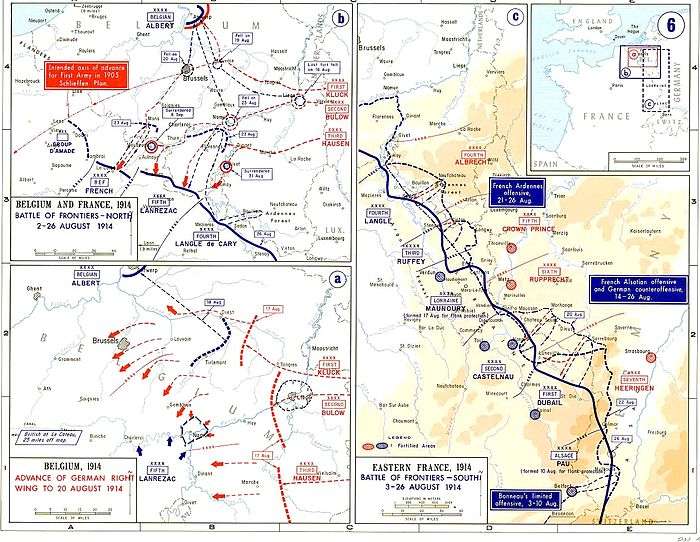
The Battle of Lorraine
| Description of the Battle of Lorraine 14 August to 13 September 1914 |
|---|
| Historians have called the period in Lorraine from 14 August to 13 September 1914 the "Battle of Lorraine" and this covers a sequence of battles including the Battle of Morhange, the Battle of the Trouée de Charmes, the Battle of Rozelieures, the Battle of the Mortagne, and the Battle of the Grand Couronné. These all involved the 2nd French Army.
South-east of Nancy the French Ist Army under General Dubail had many encounters with the Germans and apart from the fighting at Sarrebourg they fought the Battle of the Haute-Meurthe from 24 August to 11 September 1914. This will be dealt with in the article covering Alsace. After these battles a defined front line was established by late September and was not to change significantly until the end of the war, although fighting from trench to trench would occur almost daily. The short period of August to September 1914, saw the French Plan XVII shattered and this, and the ultimate failure of the Von Schlieffen plan, saw the "war of movement" end and a static war of trenches and more trenches take over. For France the death toll was notable and by the end of August, the French Army had suffered 75,000 dead of which 27,000 were killed on 22 August alone,[1] the death toll was similar to first day on the Somme. Total French casualties for the first month of the war were 260,000[1] of which 140,000 were sustained during the climactic final four days of the battle of the Frontiers. |
The Battle of Morhange-Sarrebourg in Moselle
| The Battle of Morhange-Sarrebourg in Moselle 14 to 24 August 1914. |
|---|
| This encounter is part of what is also known as the "Battle of Lorraine" and was fought from 14 August to 24 August 1914.
The French Army's "Plan XV11" set out the invasion of Lorraine and her return to France as a major objective. Annexed by Prussia after the 1870-1871 Franco Prussian War, along with Alsace, its return to France was essential. The French were therefore to give top priority to retaking Lorraine and Alsace whilst the Germans had other ideas and were intent on pursuing the Von Schlieffen plan to the north. The beginning of the war in August 1914 saw the two protagonists lock horns in the north at Charleroi, in the centre at the Ardennes and in Lorraine at Morhange and Sarrebourg, whilst in Alsace the two sides fought at Mulhausen. These early battles were identified by historians as the "Battles of the Frontiers" and the encounters at Morhange and Sarrebourg were two of them. On 14 August 1914, the French attacked on two fronts, with General Auguste Dubail leading the French 1st Army with the objective being to take Sarrebourg to the east of Nancy, whilst General Noel de Castelnau, leading the French 2nd Army, would attack Morhange. The 1st and 2nd French Army were known as the "Army of Lorraine". Both Sarrebourg and Morhange were fortified towns. Facing the French were the German 6th and 7th Armies. Prince Rupprecht had command of the 6th and overall command of both armies, with General Josias von Herringen having command of the 7th. At this stage the German Army, knowing that their major effort was taking place with the march through Luxembourg and Belgium, deliberately followed a policy of "retreat", feigning to be overwhelmed by the French, but luring them into a position where they would be vulnerable to a fierce counter-attack. "Come into my parlour said the spider to the fly." However, as the French advanced Rupprecht soon tired of such tactics and pressed von Moltke to allow him to be more aggressive. He wanted to drive forward and push the French back to Nancy. Rupprecht had his way, although this flew in the face of the blueprint of the von Schlieffen plan and on 20 August 1914, the Germans went on the offensive and the French 2nd Army were forced to retreat. Dubail and the French 1st Army could now no longer stay out on a limb attacking Sarrebourg and he also retreated, but despite the retreat of the two French armies, Foch's XX Corps were able to successfully defend Nancy. The French front-line was however now in disorder and Joffre, the French Commander in Chief, had no alternative but to order a general withdrawal and only eight days after the French offensive had begun both the 1st and 2nd Armies were back to the line Belfort-Epinal-Toul. The Germans had also pushed through the "Trouée des Charmes," a natural gap between Epinal and Toul, on 24 August, but their success was limited to establishing a small salient. The French line held and fighting continued until the end of August. Stalemate ensued. Given that they had not made any major gains, the Germans must have regretted tying up 26 Divisions in Lorraine and Alsace when these could have swung the outcome of the Battle of the Marne further to the north west. Morhange had then played an important role in the events of 1914. General Dubail with his 1st Army and General de Castelnau with the 2nd Army, had however exhausted themselves in the fruitless attacks on Sarrebourg and Morhange and the French concept of "offensive a outrance" had withered before heavy German artillery, barbed wire and the now ubiquitous machine-gun. Now the French withdrew to the line of the Grande Couronné. In effect the policy of "offensive a outrance" died in the killing fields of Lorraine and amongst the corpses of soldiers with their bright red pantaloons there were no doubt bodies of some of their officers still wearing white gloves. Rupprecht's artillery continued to pound the French lines. Ste Genevieve, near Nomeny, was battered, and it was decided that the French Army must retreat behind the Grand Couronné. The French looked for some respite and on 22 August 1914 they found it when Rupprecht took the offensive against Charmes and exposed his flank to the troops now positioned beyond Nancy. The Germans attacked, the French counter-attacked, and the German 6th and 7th Armies locked horns with the French 1st and 2nd Armies, the French backed by the guns of Belfort, Epinal and Toul. Again stalemate ensued; there was no victor. There had however been a quite horrendous loss of life. |
Battle of the Mortagne River in Meurthe et Moselle
| Battle of the Mortagne River in Meurthe et Moselle. 14 to 25 August 1914 |
|---|
| After Morhange and Sarrebourg, Castelnau's 2nd Army retreated to the Grand Couronné and Mortagne and from 21 to 23 August they withdrew from Lunéville,which was occupied by the Germans on the 22nd, and sought to make contact with Dubail's 1st Army.
When the battle started on 24 August 225,000 French soldiers faced 300,000 Germans. The Germans objective was to reach and pass the gap at Charmes which lay between the forts of Toul and Epinal to then attack Commercy, Bar-Le-Duc and Verdun from the rear. Joffre's order was to defend Nancy and hold the position in front of Charmes so that Dubail could attack the German's flank at Mortagne and on the Meurthe. On the 24th the Germans advanced from Mont-sur-Meurthe to Gerbéviller, passing the Mortagne and then attacked the fort at Manonviller which was taken on 27 August. After taking Lamath the Germans attacked towards Romain and Bayon and the French attacked their flank at Courbesseaux, Saint-Boingt, Essey-la-Côte and Damas-aux-Bois whilst the 2nd Army's artillery blasted the Germans from the Flainval plateau. On the 25th the Germans took Rozelieures, which was retaken in the afternoon of the same day. Castelnau pushed on and the 15th and 16th Army Corps retook Einvaux, Lamath, Blainville, and reached the Meurthe and the Martagne. At the same time the 8th Army Corps of the 1st French Army conquered Domptail and Saint-Pierremont. At Crevic and at Courbesseaux the struggle was bloody. From the 26th to the 29th the German offensive was broken and the ground from Champenoux to Friscati was taken. Xermanénil was retaken and now the scene was set for the Battle of Grand-Couronné and the German attempt to take Nancy. Castelnau emerged victorious on 13 September, Castelnau took Lunéville and the Germans retired to the Seille where they would dig in for four long years. From 29 August to 7 September, Dubail's 1st French Army won the battles at Rambervillers and the Haute-Meurthe including fierce and bloody fighting on the Chipotte peak. This part of the German line retreated to Parroy as far as the peak at Saales and dug down into their trenches.[2] |
The Battle of the "Trouée de Charmes" in Meurthe et Moselle

| The Battle of the "Trouée de Charmes" in Meurthe et Moselle 24 to 26 August 1914 |
|---|
| This encounter ran from 24 to 26 August 1914.
The war in Lorraine had started rather badly for the French, with her 2nd Army retreating from Morhange which left the 1st Army having to pull back from Sarrebourg. Moltke, the German Chief of Staff, drew the conclusion that the 2nd Army was a spent force and had no further role to play and saw the opportunity to strengthen the attack to the rear of the French Armies which was the basis of the Von Schlieffen plan and what the German armies to the north were already trying to achieve. Moltke thought that if he could use Rupprecht wisely then the French could be hit twice from the rear, firstly by the German armies to the north and then by Rupprecht's 6th Moltke planned that Rupprecht's 6th Army would pass through the Trouée de Charmes which passed between the Forts of Toul and Epinal and then turn to the northwest and march north to Bar-le-Duc and take the French 3rd and 4th Armies in the rear. Now all depended on Castelnau whose 2nd Army now manned the Trouée de Charmes area and he learned from his Intelligence Service, that German columns were moving to Saffais and Bechamps and heading for the gap at the Trouée de Charmes. A few hours later French aerial observers would confirm this. Now the French High Command directed General Dubail, commanding the 1st French Army to put his 8th Division at Castelnau's disposal. Dubail did this immediately and now Castelnau had much needed reinforcements and knew exactly what the Germans were up to. On 24 August Rupprecht's troops began to attack in the direction of the "Trouée de Charmes" and he concentrated this attack on the centre of the 2nd Army as this was judged to be the cornerstone of the French's defence and where they were the strongest. Initially the Germans were successful and they managed to take Damelevières and Gerbeviller and then pushed the French from Vacquenatwood, Clairlieu and Censal from where they move towards Bayon. At this point however, the French started to check the German advance, the French 74th Infantry in particular fighting with great tenacity and at the same time the Bavarians attacking the Flainval plateau were also checked by the French. Now in a desperate effort to force through the gap, the German 6th Army effectively weakened their right and left flanks which Castelnau saw and decided to use to his advantage. He attacked the German flanks with General Fayolle's 70th French Infantry and they were pushed out of Erbeviller, Réméréville and Courbesseaux. Now the right wing of the French 2nd Army attack Rupprecht's left flank and managed to take Saint-Boingt, Essey-la-Côte and Clézentaine Ménarmont. During the night of 24 to 25 August Castelnau pounded the Germans with his artillery. Now Castelnau concentrated on Rupprecht's centre and launched an attack to take Rozelieures from the Germans. He was successful but the Germans hit back and retook Rozelieures but later in the day of the 25th the French took it back. Rozelieures was theirs! On the 25th and 26th fighting was fierce in every area but finally Rupprecht ordered a retreat. 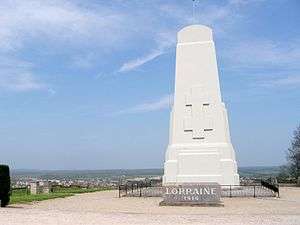 The Monument of Lorraine which celebrates the outcome of the engagements of August/September 1914 The battle of Charmes was a victory for the French 2nd Army and in stopping the Germans from passing through the "Trouée de Charmes" Castelnau had arguably saved the French from a complete disaster. To quote Maurice Barrès- "Paris a été sauvé à la Marne, c'est parce que Castelnau avait vaincu à Rozelieures" "If Paris was saved at the Marne it was because Castelnau won at Rozelieures" The Trouée de Charmes was a gap in the French defensive lines north-east of the town of Charmes. There were many fortresses around Toul and Epinal in the Vosges. But around Lunéville, in the rather open landscape of plains and hills, there was only one fortress, the Fort de Manonviller. In this open country there are three natural obstacles, being the rivers Moselle, Vezouze and Meurthe. These last two rivers link together directly west of the city of Lunéville. Any German Army which could break through the Gap of Charmes, would have been awarded with the advantage of three options to facilitate the continuation of its campaign on more accessible terrain: 1. Go right and attack Nancy and Toul, or 2. Go left, and attack St. Dié and Epinal, or 3. Advance directly to the Champagne. Another reason why this weak link in the French defensive line was called the Gap, was the fact that the French 2nd Army linked up here with the 1st Army. During the period of 20–23 August the flanks of these armies almost lost contact. During the Battle of the Trouée des Charmes from 24 until 26 August 1914, it took the French 2nd Army much effort to withstand the German attacks. It even needed the assistance of the 8e Corps d’Armée of Dubail's 1st Army. Now the two sides regrouped and on 4 September clashed again in the "Battle of the Grand Couronné" which was to last until 13 September. After that encounter the front line in Lorraine would not change for the next four years. |
The Battle of the Grand Couronné in Meurthe et Moselle
| The Battle of the Grand Couronné in Meurthe et Moselle. 4 to 13 September 1914 |
|---|
| The fighting here was also part of the "Battles of the Frontiers" and took place from 4 to 13 September 1914, the 6th German Army under Prince Rupprecht of Bavaria being pitted against the 2nd French Army under General Castelnau.
The French retreat after the fighting at Morhange and Saarbourg saw them eventually take up position on the Grand Couronné, an area of high ground to the east of Nancy, on an arc Pont-à-Mousson, Champenoux, Lunéville and Dombasie, Grand Couronné consists of a series of high ridges which dominates the plain to the east of Nancy. These ridges are La côte Sainte-Geneviève with a height of 394 metres, Le Mont Toulon with a height of 375 metres, Le Mont Saint-Jean with a height of 400 metres, the plateau of the Bois du Chapitre with a height of 400 metres, the plateau of the Bois de Faulx with the spur of La Rochette with a height of 406 metres and finally the plateau of Malzéville and the ridge called "Le Rembêtant". These ridges dominated the plain and allowed excellent observation of it. After the Battle at the Trouée de Charmes, the German's first attempt to pierce the French line at the point where the 1st Army joined the 2nd Army, the Germans decided to attack simultaneously Saint-Dié in the Battle of the Haute Meurthe and Nancy in the battle of the Grand Couronné. The fighting at Haute Meurthe will be covered when we look at the war in the Alsace area. The fighting at Charmes had been inconclusive and the capture of Nancy now became psychologically important for the Germans and the Kaiser came along to personally supervise the attacks and the French were not helped when Castelnau had to let men go to bolster the 3rd Army who were experiencing difficulties in the west. The battle opened on 4 September when the German guns opened up destroying a number of villages in the area but from the 5th to the 11th, despite heavy losses, neither side were able to take the upper hand. On 9 and 10 September the German guns opened fire on Nancy. By 12 September the Germans began to retreat and on the next day withdrew from Pont à Mousson and Lunéville which were then reoccupied by the French. The French then continued to the banks of the River Seille where the front line stabilised and did not change until 1918. It could be argued that the Grand Couronné and the fighting at the Haute Meurthe encounter helped the allies in their success at the 1st Battle of the Marne in that they kept important numbers of German troops in Lorraine. On 18 September 1914, Castelnau was made a "Grand-Officier de la légion d'honneur" and was to appear on postcards of the time under the title "The saviour of Nancy". The loss of live as a consequence of these early battles in Lorraine was horrendous. |
Memorials linked to the fighting around Morhange in Moselle
The battlefield in fact lies north-east of Nancy, east of Pont-à-Mousson, and south-east of Metz. The area includes Freméry, Riche, Chicourt,Brehain, Conthil, Lidrezing, Cutting,Dieuze, Bidestroff and Vergaville.
Monument to the 15th Army Corps in Vergaville French Military Cemetery
| Monument to the 15th French Army Corps in Vergaville's French War cemetery. |
|---|
| In the French Military Cemetery at Vergaville is another monument dedicated to the 15th Army Corps. It depicts within an arch, a Lorraine woman holding in her arms a dying soldier. The monument was organised by public subscription on the initiative of the parents of some of the victims of the fighting in the Morhange area in August 1914. It is the work of the sculptor Petit and was designed by the architect Pialat from Uzès whose son was killed at Dieuze. The inauguration took place on 22 August 1926. The cemetery at Vergaville, which is 4 kilometres north of Dieuze contains the bodies of soldiers killed in the 19 to 20 August fighting.[4] |
Monument at Bidestroff
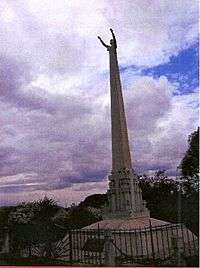
| Monument at Bidestroff to the 15th French Army Corps. |
|---|
| This memorial is dedicated to the men of the 15th Army Corps, part of the 29th Division, and to 1,204 French soldiers who lost their lives in the fighting at Morhange. The monument is located between Bidestroff and Vergaville. The men of the 15th mainly came from Provence and were the victims of a particularly heavy artillery bombardment, when caught on the high ground at Bidestroff, which left 1,204 dead on the battlefield.
It was in 1935 and on the initiative of the parish priest and the Bidestroff mayor, that a committee was set up which led to the monument being erected. Most of the funds were collected from veterans in Toulon and the Strasbourg sculptor Valentin Jaeg was commissioned to carry out the sculptural work involved. The monument is 12.5 metres high and at the top is the figure of the Archangel St Michael who raises his arms to heaven. St Michael is the patron saint of Bidestroff. At the base there are groups of crosses on each of the monument's four faces, each inscribed with the name of one of the units of the 15th Army Corps. These surround the Cross of Christ. The inscriptions on the monument read "Au XVè corps 19 et 20 août 1914" and " Aux 1204 morts du cimetière militaire de Bidestroff, 1914-1925" |
French Military Cemetery at Riche
| French Military Cemetery at Riche |
|---|
| The Riche French Military Cemetery lies midway between Morhange to the north and Riche to the south.
There is a monument located in the Riche Military Cemetery that remembers the men who fell fighting at Morhange. Riche lies just to the south of Morhange. The inscription reads "Aux Heros au Champ d’Honneur en Terre Lorraine 19-20th August, 1914 Morts pour La France" At the side of the cemetery is a small chapel dating back to 1928. This has been roped off from the public owing to falling masonry. This is a pity as there are some magnificent stained glass windows in the chapel, of which four tell the history of the 20th Infantry Division. The cemetery contains the remains of 2,574 French soldiers with 1,088 individual graves and two ossuaries containing the remains of 1,486 men. 577 of these were not identified. Most of those buried were killed in the fighting at Morhange. This particular cemetery contains the grave of the son of General Joseph Curières de Castelnau, who was killed on 20 August 1914. There are also 158 Russian graves of a later war period and a Russian mass grave with an unknown number of Russian soldiers buried in it.[7] Cemetery at Riche with monument and two ossuaries visible to the rear |
Memorial to the Battle of Morhange
| Memorial to the Battle of Morhange. |
|---|
This simple obelisk in granite remembers the soldiers who died in the battle of Morhange. Erected in the inter-war years it was destroyed by the Germans during their occupation in the Second World War and rebuilt in 1964. Near to the obelisk there is a mounted map showing the field of battle so that one can visualise the events of the two days of the battle. The monument was inaugurated on 20 August 1921 and has a height of 10 metres. It carries the simple inscription "Aux soldats français tombés glorieusement à la bataille de Morhange, les 19 et 20 août 1914"  Memorial to the Battle of Morhange |
Franco-German in Frémery
| Franco-German ossuary in Fremery. |
|---|
| This comprises two ossuaries, one for German soldiers and the other for French soldiers. The German ossuary contains the human remains of 13 unknown soldiers whilst the French ossuary contains the remains of 176 French officers and soldiers of the 146th Infantry. All the men involved were killed nearby on 20 August 1914.[9] |
The German War Cemetery at Morhange
| The German War cemetery at Morhange |
|---|
| This cemetery holds the remains of 4,753 German soldiers. 1,965 soldiers have individual graves and there are two ossuaries containing the remains of 2,788 soldiers, of whom 72 men are unknown. The German War Cemetery of Morhange was created by the German military administration in August 1914, during the Battle of Morhange as part of the existing German garrison cemetery. After the war, the French military authorities exhumed the French war dead and took them to their own cemetery and the bodies of German soldiers were collected from many other locations in the area and re-buried in this cemetery. The soldiers buried here were fighting in the area during the period of 20 to 23 August 1914 and early September. Later additions to the cemetery were the bodies of men who had fallen during the trench fighting in the years 1915-1918 or who died of their wounds in the nearby military hospitals. The majority of the soldiers buried here belonged to military units from Bavaria but there were also soldiers from Thuringia, Brandenburg, Alsace, Lorraine, Silesia, West Prussia, Hesse-Cassel, Mecklenburg and Schleswig-Holstein and Hanover and Brunswick.[10]
In Lorraine there are also German Military Cemeteries at Bouillonville holding the remains of 1,368 soldiers, at Fey where 2,006 soldiers are buried with 500 unidentified. There is also a German cemetery at Thiaucourt with the remains of 11,685 soldiers. 2,980 of these are in an ossuary of which 2,645 could not be identified. In Bertrimoutier the cemetery is a joint Franco-German one and holds the remains of 6,749 German soldiers and 950 French soldiers. |
Memorials and Cemeteries in Moselle
The war memorial at Sarreguemines
| The French War cemetery at Sarreguemines. |
|---|
| The Sarreguemines monument stands in the Place du Général Sibille, facing the Palais de Justice and remembers the victims of the 1914-1918 war. It was inaugurated in 1933. The architect Henri Giraud designed the monument and the sculptural work was carried out by Jules Déchin.
At a later stage a plaque was added acknowledging the victims of the Second World War. At the base is an allegorical representation of the town of Sarreguemines and at the summit is a bronze depicting the "Angel of Victory"[11] 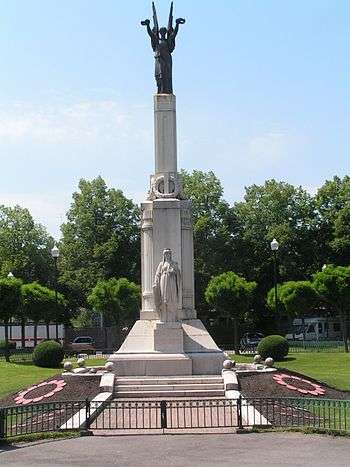 The war memorial at Sarreguemines |
Lidrezing
| The French War cemetery at Lidrezing. |
|---|
| The French War cemetery here holds the remains of 549 French soldiers from the 53rd, 58th, 69th and 79th French Infantry (the 15th, 16th and 20th Army Corps). These remains were from burial plots in Lidrezing, Zarbeling and Wuisse. There are 116 individual graves and two ossuaries. 203 of those who lie in these ossuaries were unidentified. |
Conthil
| The French War cemetery at Conthil. |
|---|
| The French War cemetery here was created in 1914 after the fighting of 20 August 1914. The cemetery contains an ossuary containing the remains of men from the 37th French Infantry regiment and there is also a monument dedicated to the 37th, inaugurated on 22 August 1922. |
Cutting
| The French War cemetery at Cuttng. |
|---|
| The French Military cemetery here contains the grave of General Paul Émile Diou (1855-1914) who was a général de brigade.[13]
The cemetery is called "L'Espérance" and was created in 1914 after the fighting at Morhange. Bodies were also gathered in from Loudrefing, Bénestroff, Dieuze, Guinzeling and Lostroff. There is a monument in the cemetery with sculpture by Charles Petit dedicated to the men of the 15th Army Corps killed in 1914 fighting at Dieuze. This was inaugurated 1 July 1934.[14] |
Dieuze
| The French War Cemetery at Dieuze. |
|---|
| The French National cemetery holds a monument which remembers those French soldiers killed fighting at Dieuze on 19, 20 and 21 August 1914. This was inaugurated on 16 September 1934 and the sculptural work is by Charles Petit who was born in Dieuze.
There are also two ossuaries in the cemetery which contain the remains of both French and German soldiers who died fighting in the area and at the Dieuze military hospital. There is also a monument dedicated to those Roumanian prisoners of war sent to Alsace-Lorraine by the Germans in 1917 and 1918. 940 of these died in captivity and are buried at Dieuze. The inscription reads "Aux soldats roumains 1916-1919. A la mémoire des 2344 prisonniers de guerre roumains morts dans les camps d'internement allemands en Alsace et en Lorraine en 1917 et 1918, à la mémoire des Alsaciens et des Lorrains qui les ont aidés à survivre. A la fière douceur de leur victoire unie, dormez au sol de France enfants de Roumanie" - 2,344 men were to die in captivity and the inscription adds a thank you to the kindness of the people of Alsace and Lorraine. Also in Dieuze there is a memorial to those French soldiers who were killed fighting in Roumania. The sculptural work here is by Remus Botar Botarro and the monument was inaugurated on 9 November 1998.[15] |
Monuments linked to the Battle of the Grande Couronné in Meurthe et Moselle
The Military Cemetery at Courbesseaux
| The Military Cemetery at Courbesseaux |
|---|
| Courbesseaux in Meurthe-et-Moselle found itself in the thick of the fighting on 25 August 1914, and was totally destroyed during the war. The military cemetery here holds the bodies of 2,679 soldiers many of whom had died at Grand-Couronné. 1,703 of the dead could not be identified and their remains lie in 2 ossuaries. There are two monuments in the cemetery. One by Eugène Gatelet was erected in 1924 and shows a young peasant laying a wreath on the tomb of a soldier and in 1964 a simple monument was erected in memory of Edouard de Castelnau,[16][17] |
The memorial to the 11th Division at Léomont
| The memorial to the 11th Division at Léomont |
|---|
The most south easterly point of the Grande Couronné was at Léomont where the ground rises to 377 metres giving excellent views over the surrounding countryside and it was an important hill to hold to protect Nancy. Fierce fighting took place here in 1914 between the French 11th Division and German units from Bavaria. Indeed, on the night of 25 to 26 August 1914 the area changed hands 8 times. The 11th Infantry Division, comprised the 26th, 37th, 69th and 79th Infantry Regiments as well as gunners from the 8th and sappers from the 20th, and was known as the "Iron Division". The citation on the monument reads ""A la 11ieme division. La Lorraine et La France reconnaissantes Ici La division de Fer Arreta la ruée allemande" Apart from their efforts at Léomont, the 11th had fought at Lunéville and Friscati and had played an important role in protecting Nancy. The original monument, erected in 1922, was destroyed by the Germans in 1940 and reconstructed in 1950. It depicts a soldier mounting guard and protecting Nancy. The original sculpture was the work of Gaston Broquet and when the monument was rebuilt the sculptor, J.Sinapi, faithfully copied Broquet's original work. [18] 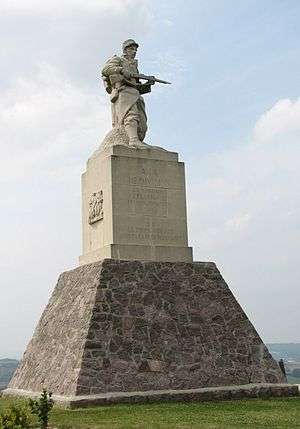 Memorial to the 11th Division at Léomont |
The War Memorial at Samogneux
| The War Memorial at Samogneux |
|---|
| The War Memorial here features a sculpture by Gaston Broquet which depicts a terrified young soldier trying to put his gas mask on, The work is entitled "L’alerte aux gaz"[19]
Samogneux was involved in the Battle of Verdun and the French Infantry Regiments 112th, 173rd, 126th and 335th fought there. |
The monument at Ste Geneviève
.jpg)
| The monument at Ste Geneviève |
|---|
Sainte-Geneviève is located in Meurthe et Moselle, south of Pont-a-Mousson and east of Nomeny and is in the area known as the Grand Couronné where most of the 2nd French Army found themselves after the Battle of the Trouée. The latter had been the German's first attempt to break the French line after the encounters at Morhange and Sarrebourg, and they now decided to mount two major attacks on the French. One was aimed at Saint-Dié and resulted in the Battle of the Haute Meurthe and the second was aimed at taking Nancy and led to the Battle of Grand Couronné. One of the monuments dedicated to the memory of this battle is at Ste Geneviève and is known as the "Monument du Grand Couronné". The monument stands on the heights of the Côte de Ste Geneviève and it was here that the French stationed their 59th Reserve Division. The monument is inscribed "To the Defenders of the Grand Couronne August–September 1914 in memory of Louis Marin." Marin was an influential local politician and the leader of the "National Republican Party" of Meurthe-et-Moselle, the President of the General Council of Nomeny and from 1934 to 1952 he was Chairman of the General Council of Meurthe-et-Moselle. The monument is somewhat worn and at each end of a curved wall are depictions of Joan of Arc and St Genevieve. |
Croix des Carmes and the Bois-le-Prêtre
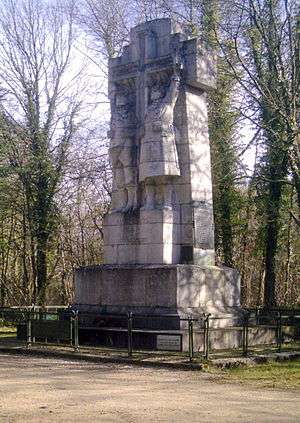
| Croix des Carmes and the Bois-le-Prêtre |
|---|
| This handsome monument, as shown above, is located in the Bois-le-Prêtre near Montaumont not far from Pont-à-Mousson in the Meurthe-et-Moselle. Between September 1914 and July 1915 there was fierce and bloody fighting here between the French 73rd and 128th Infantry Division (known as the " Wolves of Bois-le-Prêtre") and the German 121st Infantry Division. and a wooden cross was erected by the French soldiers and called the "Croix des Carmes". This cross was subsequently moved to the French War cemetery at Pétant for protection.
In 1923 the soldiers who had fought at Bois-le-Prêtre raised funds to replace the original cross with this monument. The sculptural work is by Emile Just Bachelet. His composition involves a large cross whose transverse is supported by two soldiers. One wears the uniform worn by the French in 1914 and the other the standard uniform worn at the war's end. The original cross has been bedded into the monument and the Bachelet's maquette is held in the Musée de l'École de Nancy. Raymond Poincaré attended the inauguration which took place on 23 September 1923. The stained glass artist Jacques Grüber depicted the inauguration in 1924 on a window in the church of Saint-Gorgon in Fey-en-Haye nearby. |
The Military Cemetery at Champenoux

| The Military Cemetery at Champenoux |
|---|
| This cemetery at Champenoux in Meurthe et Moselle, was created in 1919 and holds the remains of many of the victims of the Grand-Couronné battle. The cemetery holds 2,862 bodies of whom 1,261 could not be identified and lie in 3 ossuaries. In the cemetery there is a granite monument with a bronze relief by Eugène Gatelet. It was erected by Souvenir Français in 1921 and is dedicated to "aux héros du Grand-Couronné". Gatelet also worked on the monument to General Édouard de Castelnau located in the French Military Cemetery at Courbesseaux |
Other monuments, memorials and cemeteries in Meurthe et Moselle
Nomeny

| Nomeny |
|---|
Nomeny was occupied by the Germans on 20 August 1914, the village was plundered, burned down and some 55 women, children, and elderly people slaughtered. The Governor of Metz, General von Oven had ordered the destruction of Nomeny as a reprisal for the French attack in front of Morhange. German soldiers had been fired on by so-called "Francs-tireurs." The names of 63 people who were killed are listed on the monument as well as 12 people who were badly injured. Similar events took place in Badonviller, Bréménil, Blâmont and Gerbéviller. Nomeny and nearby Brionne were to see fierce fighting on 20 August 1914 and there is a monument dedicated to the memory of the soldiers of the 59th Reserve and the 277th, 325th and 314th French Infantry who fell fighting to the north of the Grand Couronne and the River Seille and who as stated on the memorial "Barrer La Route de Nancy a l'Envahisseur" In Brionne there were it seems other more sinister events "A Brionne fut arrete L'Ennemi après L'Incendie et La Meurtre inqualifiable de 70 habitants de Nomeny" |
Nancy
Nancy was never occupied by the German army in the 1914-1918 war but was in the sights of their artillery and was constantly shelled.
The war memorial in the Cimetière Sud in Nancy
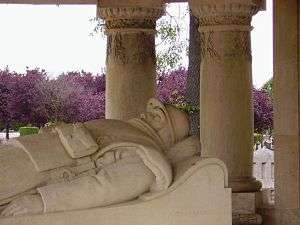
| The war memorial in the Cimetière Sud in Nancy |
|---|
| The large cemetery located in the south of Nancy has a memorial dedicated to all those soldiers who fell in the 1914-1918 war. Nancy had been occupied by the Germans in the 1870-71 war but in August 1914, General Castelnau's troops managed to stem the German offensive and saved Nancy at the Grand Couronné encounter. Many French soldiers were wounded in this battle and were sent to the hospital at Nancy and those who did not survive are buried in this cemetery.
Underneath an elaborately carved granite canopy and supported by columns, is a sculpture of a reclining soldier which is reminiscent of the "Soldat du Droit" at Fleury-devant-Douaumont in the Meuse and around the canopy are inscribed "les frontières"; the names of the main areas of the conflict- "Yser, Artois, Marne, Somme, Champagne, Aisne, Verdun, Argonne and Grand Couronné". A photograph of the monument is shown here. [21][22] |
Monument in Nancy's Cimetière Sud to the civilians of Nancy
| Monument in Nancy's Cimetière Sud to the civilians of Nancy |
|---|
During the German artillery shellings mentioned above, many civilians lost their lives and they are remembered in a monument in the Cimetière Sud. Their graves encircle a simple square concrete memorial which has their names engraved on it. A small plaque has been added to remember the dead of the 1939-1945 war when Nancy was occupied by the Germans. A photograph is shown below.
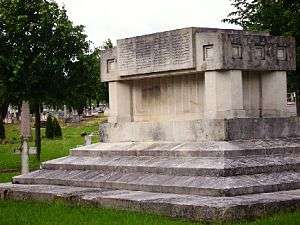 Monument to civilians of Nancy killed 1914-1918 The main inscription reads "Aux Victimes Civiles de la guerre 1914-1918" |
Memorial to the 37th Infantry Regiment at Cimetière Sud in Nancy
| Memorial to the 37th Infantry Regiment at Cimetière Sud in Nancy |
|---|
In the Nancy Cimetière Sud there are many regimental memorials including an obelisk dedicated to the casualties of the 37th Infantry Regiment. At the base is this sculpture of a grieving woman.
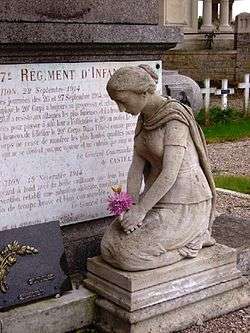 Memorial to 37th French Infantry Other memorials in the cemetery are dedicated to the 5th Regiment of Hussars, the 69th French Infantry, the 79th French Infantry and the 8th Regiment of Artillery.[24] [25] |
War memorial at Dombasle sur Meurthe
| War memorial at Dombasle sur Meurthe |
|---|
| At Dombasle sur Meurthe in Meurthe et Moselle is this poignant war memorial. A soldier is depicted telling the children of Dombasle sur Meurthe the story of the 1914-1918 war.
There is also a monument in the town dedicated to the soldiers of the 20th Company of the 212nd French Infantry who were killed in the fighting on 23 August 1914, when the Germans were prevented from occupying the town. They were led by a Colonel Brau. The inscription reads "Le Colonel Brau, Défenseur de Dombasle, a évité à la ville d'être occupée par l'ennemi le 23 août 1914 grâce à son courage et à celui des vaillants soldats de la 20e Compagnie du 212e Régiment d'Infanterie" This monument is situated at the crossing of the Rue du Colonel Brau and La Place du Souvenir Français. [26]  War memorial at Dombasle sur Meurthe. Frenchman tells children of the Great War |
Gerbéviller
| Memorials in Gerbéviller |
|---|
There is a monument in Gerbéviller in Meurthe et Moselle dedicated to the 74th Infantry. The inscription reads
"A la mémoire des Héros de la 74e D.I.R., Défenseurs de Gerbéviller : 36e R.I.C. - (222e - 223e - 230e - 299e - 333e Régiments de Réserve) - 27/08/1914 - 02/09/1914" This monument stands alongside the road skirting the two war cemeteries in Gerbéviller, one French and one German.[27] The war memorial at Gerbéviller is dedicated in particular to the chasseurs of the 2nd Brigade commanded by an adjutant called Chèvre, who held a Bavarian brigade at bay . The sculptural work is by Émile Just Bachelet. The French war cemetery was created in 1920 and holds the remains of many of the soldiers who died in the fighting at the battle at Trouée des Charmes in August 1914. Total burials are 1,121. [28] The German war cemetery holds the remains of 4,335 soldiers.[29] |
The war memorial at Lunéville
| The war memorial at Lunéville |
|---|
| Originally dedicated to the victims of the 1914-1918 war, this memorial was later changed to include the dead of the 1939-1945 conflict and now bears more than 1,400 names. It was designed by the architects André Gutton et G. Grange and the sculptural work was by Claude Grange. The memorial was inaugurated on 19 June 1927 and comprises two large stone pylons with a woman on horseback at the top of each pylon. The depiction of horses reflects the fact that many cavalry units were garrisoned here at the start of the war including the 2nd Cavalry Division.[30] |
The Lantern of Death in the French War cemetery at Rozelieures
| The Lantern of Death in the French War cemetery at Rozelieures |
|---|
| There is a depiction of the "Lantern of Death" in the cemetery at Rozelieures which remembers the dead of the Battle of Rozelieures August–September 1914.
The inscription lists all the French units involved "On pris part à la Bataille : 2e, 6e 10e Division de Cavalerie |
The "Fontaine de la République" memorial on the Le Chapolette peak
| The "Fontaine de la République" memorial on the Le Chapolette peak |
|---|
This drinking fountain at Le Chapolette, was created by some soldiers of the 338th French Infantry themselves and is inscribed
"En souvenir des soldats corses et méridionaux, morts ici, en combattant pour une juste cause - souvenez-vous que sous ce sol reposent à jamais des combattants français et allemands, morts dans une impitoyable guerre de mines. Les châtaigniers qui prospèrent sur ce sol sont un souvenir de leur passage et de leurs beaux pays" |
The monument to the 38th and 86th French Infantry at Baccarat
| The monument to the 38th and 86th French Infantry at Baccarat. |
|---|
| The 86th Infantry Regiment was a regiment from Velay in the Haute-Loire. They earned much glory during the war and particularly during the battle of Baccarat on 25 August 1914. Baccarat is crossed by the River Meurthe which runs through it from south to north and in the town centre is an important bridge which carries the road that connects Rambervillers to Sarrebourg. It was here that the 86th fought with great bravery and lost 90 men with many more injured. In 1927 the people of Baccarat had a monument erected in the form a large white cross this dedicated to the soldiers of the 86th.
The inscription on the monument which also remembers the soldiers of the 38th French Infantry reads "A la mémoire des officiers, sous officiers, caporaux et soldats des 38e et 86e R.I., tombés glorieusement en combattant dans nos rues et dans nos champs, le 25 août 1914, qui trouvèrent ici une sépulture provisoire. Le Souvenir Français, 1927". . The monument is situated where the Rue des Trois fontaine crosses the Rue de Saint-Christophe. |
The war memorial at Badonviller
| The war memorial at Badonviller |
|---|
| This war memorial is near to the church of Saint-Martin in Badonviller and has at its summit a sculpture which features three figures. In the centre is a depiction of a grieving woman whilst to her left is a soldier and to her right another woman in tears. The soldier remembers all those who fought in the area whilst the woman in tears recalls the city's suffering during the artillery bombardments of 1914. The monument was designed by the Nancy architect
H. Antoine and the sculptural work was by the Parisien sculptor Emile Just Bachelet.[34] |
Monument to the 358th French Infantry
| Monument to the 358th French Infantry |
|---|
| Finally in Badonviller's war cemetery there is a monument dedicated to the 1,564 men of the 358th French Infantry.
The inscription reads "Monument élevé à la mémoire de nos chers camarades du 358e R.I. Morts pour la France au cours de la Grande Guerre. Hommage fraternel des anciens combattants du 358e R.I. et de leurs amis. 14 juillet 1924" |
The French War Cemetery at Vitrimont-Friscati
| The French War Cemetery at Vitrimont-Friscati |
|---|
This cemetery lies to the east of Vitrimont in an area known as the Mouton Noir. It was created in 1918 by the dedicated efforts of Marie-Marguerite Wibrotte who organised the collection of the bodies of 3,751 soldiers who had died fighting at Vitrimont, as well as at Léomont, Crévic and Bonviller between August and September 1914, the days of the fighting between Ruprecht's 6th German Army and Castelnau's 2nd French Army. 1,683 of these soldiers could not be identified and their remains were put into 3 ossuaries. There is also a chapel in the cemetery, again organised by Miss Wibrotte, as a refuge for those visiting the cemetery and this has frescos painted by Burguin, an artist from Lunéville. A large calvary dominates the cemetery and in 1927 a monument was added depicting a soldier standing under a triumphal arch, this by the sculptor Cochinaire. Another monument was added in 1968 dedicated to the memory of Marshal Lyautey. It comprises three arches brought from his original memorial in Rabat, Morocco.
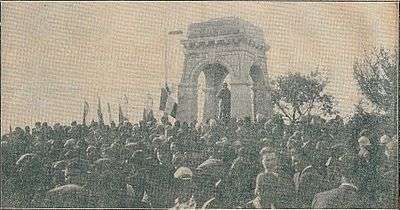 The inauguration of Cochinaire's Triumphal Arch |
Monuments and cemeteries in the Vosges
The Battle of the Haute Meurthe
After the defeats at the Battles of Lorraine and Sarrebourg, the 1st French Army retreated to the banks of the River Meurthe where they were involved in a series of encounters with the Germans in what is called the Battle of Haut-Meurthe which ran from 23 August to 10 September. There was fighting in front of Rambervillers on the Chipotte mountain and Saint-Barbe, at Saint-Dié, Mandray, the Anozel mountain and at Taintrux and Nompatelize.
These encounters were all of a defensive nature but after 11 September they became of an offensive nature with the 13th, 21st and 14th Army Corps and the "Vosges Army Group" playing important roles and in this area between Nancy and the Hautes Vosges the front line was defined and changed little until the end of the war in 1918 but saw fierce exchanges between the two sides trench to trench.
Memorial to the 363rd French Infantry in Badonviller's French War Cemetery
| Memorial to the 363rd French Infantry in Badonviller's French War Cemetery. |
|---|
| In the French war cemetery at Badonviler there is a monument which remembers the efforts of the 363rd French Infantry at La Chapelotte. See photograph below.
The cemetery contains the remains of 2,653 Frenchmen of whom 1,209 lie in two ossuaries. The bodies here were moved from smaller burial plots at Angomont, Badonviller, Baccarat, Montigny, Neufmaisons, Pierre-Percée and Saint-Maurice. |
The Mountain pass at La Chapelotte
| The Mountain pass at La Chapelotte |
|---|
This pass has a height of 447 metres and stands between the Donon and the Royon l'Etape and was strategically important linking the plain of Lorraine and the Vosges Massif. Throughout the war there were fierce encounters between the French and Germans. Many of the battles were fought underground and there was much tunneling and the use of explosive mines set off under the opposition's trenches.
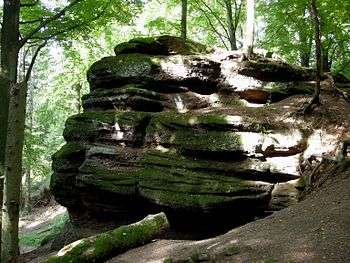 Soldiers grotto at La Chapelotte There is a fountain here erected by the soldiers of the 338th Infantry as mentioned above. The area had many grottos and one of these is known as the "Grotto des Poilu" and was used as a first-aid post by the soldiers of the 43rd Territorial Infantry. At the top of the mountain there is a monument which reads "Aux Morts Glorieux du 363e R.I." |
The Col de la Chipotte
| The French Cemetery at the Col de la Chipotte | |
|---|---|
 |
This pass is in the Vosges east of Saint-Dié and west of Rambevilliers. There was fierce fighting here from 25 to 11 September with the area changing hands several times. In the Chipotte French War cemetery there is a monument to the men of the 86th Brigade and another to the 2nd Brigade Coloniale. The cemetery has 1,006 individual graves and two ossuaries holding the remains of 1,899 soldiers whose remains could not be identified. Incidentally French soldiers called la Chipotte "Le Trou de l 'Enfer" (The Hell Hole)
the Hell Hole. 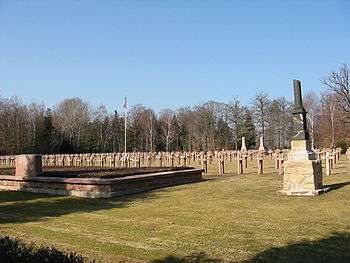 French War cemetery at Chipotte |
"Pour la France" a bas-relief at the French Cemetery at Pierre-Percée
| "Pour la France" a bas-relief at the French Cemetery at Pierre-Percée |
|---|
| This monument with a bas-relief by Antoine Sartorio was erected in 1915 and is dedicated to all the combatants who fought at La Chapelotte and in particular the 363rd Infantry Regiment.[37]
The monument bears the inscription "La Chapelotte 1914-1918. En ces lieux la guerre avait fait d'une magnifique forêt une terre chaotique. La nature en paix a repris ses droits et cicatrise ses plaies. Mais reste le souvenir des quelques 2 000 combattants français tombés ici pour notre indépendance" |
The War Memorial at Raon-l'Etape
| The War Memorial at Raon-l'Etape |
|---|
| The war memorial here features a bronze by Gaston Broquet entitled "La Patrouille".
The area around Raon-l'Etape saw much action in the period August/September 1914 and this particularly involved the 21st battalion of the "chasseurs à pied" When the prospects of war loomed, the French started to garrison the area of the valley of the river Meurthe near to the Franco-German border. Troops were moved to towns such as Baccarat, Senones, Saint-Dié, and Raon-l'Étape, where the barracks were known as the "Dutertre" barracks and covered the route to Celles-sur-Plaine and Donon. The 21st arrived on 10 October 1913 and on 31 July 1914, the battalion took up positions around Celles-sur-Plaine and Allarmont. Once war broke out the battalion fought at Petit Donon. After the fighting at Morhange the 1st and 2nd French armies retreated towards the Meurthe. The 13th French Infantry division fought at Badonviller, Raon, La Neuveville-lès-Raon, La Haute-Neuveville and La Chipotte then at the end of 21 August left the Vosges to fight in the Battle of the Marne and were then involved in the Race for the Sea fighting at various points as the front line snaked northwards. During the war almost 2,300 chasseur (riflemen) were killed including men from Raon-l'Étape and La Neuveville. On 24 August, the 21st Army Corps passed along the left bank of the Meurthe and the 20th and 21st battalions of the "Chasseur a pied" fought in the town of Raon-l'Étape itself until they retreated to Haute-Neuveville. and the Chipotte mountain, fighting as they went. The Battles of the Meurthe followed including the fighting at Grand Couronné, the Trouée de Charmes, at the Chipotte and in the la Haute Meurthe. all of which ran through until early September. Finally the Germans were halted along the line of the Meurthe. During all this fighting Raon-l'Étape was occupied by the Germans for 19 days. Now the front line was stabilised parallel with the right bank of the Meurthe and running from La Chapelotte to La Fontenelle and this front line was not to change until the end of the war. The war memorial here features a sculpture by Gaston Broquet and it is recorded that the interior of the war memorial contains an urn with a sample of soil of the battlefield of Douaumont near Verdun. Broquet had had experience of the war having served in the 94th French Infantry. Broquet's work can be seen in the depiction of the wounded Sergeant Maginot in the Maginot memorial near Fort de Souville and the horrified Poilu with gasmask of Samogneux.[39] 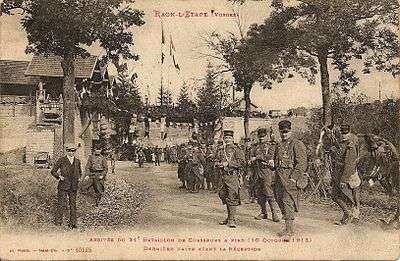 The 21st battalion arrive at Raon-l'Etape |
Senones
Senones lies north of Saint-Dié-des-Vosges and east of Raon-l'Étape.
There is a German War cemetery or Kriegsgräberstatte at Senones which contains 1,528 German burials. Of the 1,528 soldiers 784 are buried in a grave, and 22 individual soldiers of them are unknown. The mass grave contains the remains of 744 killed soldiers, only 348 of them are known by their name. The "Schlacht in Lothringen" or the "Battle of Lorraine" from 25 to 28 August 1914, the defensive fighting in the winter 1914-1915, the trench warfare of 1915, and the war in late 1918 increased the number of dead in this sector of the front. Soldiers, buried here, came from garrisons in Bavaria, Baden, Hessen, Hanover, Brunswick, Ostfriesland, Wurttemberg, Westphalia, Thuringia, Brandenburg, Silesia and the Rhineland. On 25 August 1914, the Germans entered Senones on their march on St. Dié des Vosges and after the battle at la Chipotte and on 12 September 1914, units of the 30th Bavarian Reserve Division passing the defenceless town of Senones whilst retreating to return in the evening to occupy the town.
There is also a French War cemetery at Senones which contains the graves of 795 French Soldiers, including colonial soldiers. 372 of these soldiers are buried in 2 ossuaries. There are also 6 Poles, 11 Roumanians and 6 Russians buried in the cemetery. Soldiers buried here were brought in from the battlefields in the area around Bois du Palon, Bois "Y", la Scierie de Malfosse, la Chapelle de la Halte, the nearby Mère Henry and the Haute-Forain.[40]
Saint-Dié-des-Vosges
| Saint-Dié-des-Vosges. The War Memorial and cemetery. |
|---|
| The original war memorial at Saint-Dié-des-Vosges was a most elaborate one with a French soldier at the top crushing the German Imperial eagle, the figure of Déodat, the founder of the town, and General Haxo and other figures, but this was demolished by the Germans during the occupation in the Second World War as they wanted to melt down the bronze for munitions manufacture. Symbolically the town has left just the base of that monument standing as a reminder of the suffering which the town endured from 1940 to 1944, in particular the town's burning in 1944.[41]
There is a French War cemetery at Saint-Dié-des-Vosges called "Les Tiges" which contains the remains of 2,608 French soldiers of which 1,182 could not be identified and lie in two ossuaries. The men buried here were brought in from Ravin, la Côte, Mailleufaing, La-Salle, Saint-Rémy and Nompatélize.[42] Another memorial to those who died fighting in 1914-1918 stands in the cemetery. See photograph below.  War Memorial in Saint-Dié-des-Vosges French War cemetery |
Ban-de-Sapt
| The War Memorial at Ban-de-Sapt by Ėmile Just Bachelet |
|---|
| The 1914-1918 war memorial in this Vosges town stands in front of the town hall and a sculpture of a female figure representing the "Republic" is by Emile Just Bachelet. The words "Courage - Tenacité - Audace - Endurance" are inscribed on the memorial's base.[43] |
The French War cemetery at La Fontenelles
| The French War cemetery at La Fontenelles. | |
|---|---|
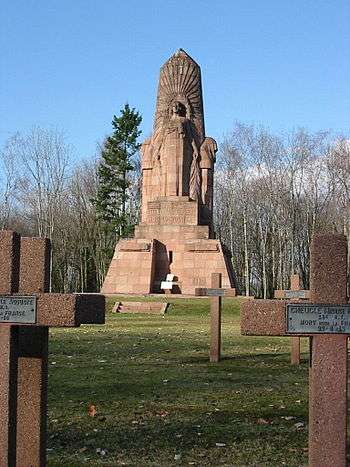 Monument de La Fontenelle |
Ban-de-Sapt or Launois lies north of St Die des Vosges and between La Grande Fosse and the Petite Fosse.
There is a hill known as "La Fontenelles" near to Ban-de-Sapt which was strategically important in 1914, and on 14 September the 1st French Army took the area. Thereafter the Germans made every effort to retake it and as time went on it became a trench area where many tunnels were excavated and underground explosives detonated. The front line eventually ran along the flanks of the hill. In 1915 the fighting was more intense and the French were able to gain some ground. In the French War cemetery of "La Fontenelle" at Ban-de-Sapt, there is a monument remembering those killed in the 1915 fighting which includes the depiction of a Marianne and a French soldier. See photograph above. This cemetery contains the remains of 1,384 Frenchmen of whom 424 lie in an ossuary. It was established in 1925. [44] |
Bertrimoutier
| The French War Cemetery at Bertrimoutier |
|---|
| The French War cemetery here holds bodies brought in from La Chapelle Sainte-Claire, Mézé, Violu, Coinchimont, Québrux, Haute-Goutte, the camp at Gude, the farm at Mathis, the Pré de Raves, Lesseux, Provenchères and La Croix-le-Prêtre. French burials total 953, with 12 Russian and I Roumanian grave.[45] |
Some conclusions
The outcome of the battles in Lorraine and Alsace in 1914 effectively meant that the French plan XVII had failed and during the same period, and under tremendous pressure from the German armies advancing in the north, the French and British armies had begun the Great Retreat to the Marne River, pivoting on the fortress of Verdun. So serious did he perceive the situation that Sir John French favoured withdrawing the BEF to the coast of the English Channel from where it could be evacuated, as he judged the BEF to be vulnerable and exposed but the British Secretary of State for War, Lord Kitchener, who ironically had never been in favour of the BEF's role alongside the French army, now insisted they stay side by side with the French.
The German Von Schlieffen Plan was now starting to show cracks and Moltke was too prone to wavering and lacked the firm hand that was required. The German right wing had been weakened by the need to shift men and resources to bolster the offensive in East Prussia and to hold ground in Lorraine and Von Kluck's decision to take his First Army east of the French capital rather than keeping to the west of Paris, as Von Schlieffen had insisted should happen, had exposed his right flank which the Allies exploited in the First Battle of the Marne in early September, enabling the German advance to be halted.
The French no longer saw themselves achieving a swift, decisive victory and their priority now was to avoid defeat. Joffre, blamed the failure of Plan XVII squarely on the shoulders of his subordinates, claiming defeat stemmed from "grave shortcomings on the part of commanders."[46] and many were sacked and even Lanrezac failed to escape Joffre's axe and was retired.
Gallery of images
 Monument at Ste Géneviève
Monument at Ste Géneviève Monument at Ste Géneviève
Monument at Ste Géneviève Emmanuel Benner's 1895 painting "The loss of Alsace Lorraine" depicts France comforting Alsace-Lorraine, lost to the Germans in the Franco-Prussian war.
Emmanuel Benner's 1895 painting "The loss of Alsace Lorraine" depicts France comforting Alsace-Lorraine, lost to the Germans in the Franco-Prussian war.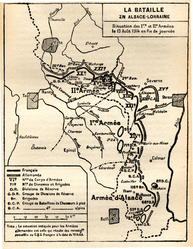 Map showing position of armies on 19 August 1914 prior to fighting at Morhange-Sarrebourg.
Map showing position of armies on 19 August 1914 prior to fighting at Morhange-Sarrebourg.- An old German map of "German Empire" showing Lorraine, the Basse Alsace and Haut Alsace.
 French soldiers in trench.
French soldiers in trench.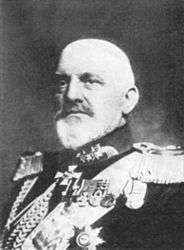 The German General Josias von Heeringen.
The German General Josias von Heeringen. Prince Rupprecht of Bavaria.
Prince Rupprecht of Bavaria. Auguste Dubail Commander of French 1st Army.
Auguste Dubail Commander of French 1st Army. General Castelnau shown on the left commanded the 2nd French Army, Joffre in the centre was the French Commander in Chief. General Pau shown to the right commanded the "Army of Alsace".
General Castelnau shown on the left commanded the 2nd French Army, Joffre in the centre was the French Commander in Chief. General Pau shown to the right commanded the "Army of Alsace". Crosses mark soldier's graves in the "Petant" cemetery
Crosses mark soldier's graves in the "Petant" cemetery Some of the ruins of Gerbeviller
Some of the ruins of Gerbeviller French soldiers at Le Chapelotte.
French soldiers at Le Chapelotte.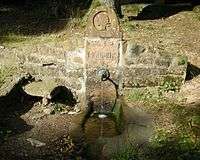 Drinking fountain erected by French soldiers at Le Chapolette.
Drinking fountain erected by French soldiers at Le Chapolette. The French and German Cemeteries at Bertrimoutier
The French and German Cemeteries at Bertrimoutier Memorial at La Chapelotte
Memorial at La Chapelotte Sculpture by Paul Dubois in the place Maginot in Nancy. Called "Le Souvenir" it remembers the loss of Alsace and the Moselle in the Franco-Prussian War
Sculpture by Paul Dubois in the place Maginot in Nancy. Called "Le Souvenir" it remembers the loss of Alsace and the Moselle in the Franco-Prussian War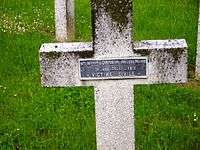 The grave in Nancy South cemetery which marks the burial of one of the civilian killed in the German bombing of Nancy 1914-1918.
The grave in Nancy South cemetery which marks the burial of one of the civilian killed in the German bombing of Nancy 1914-1918. Crosses at the base of the Bidestroff monument.
Crosses at the base of the Bidestroff monument.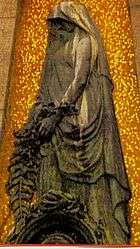 Bronze at Chamenoux by Gatelet
Bronze at Chamenoux by Gatelet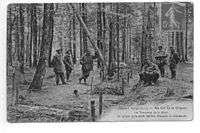 taken after the fighting at the Col de la Chipotte in August 1914.
taken after the fighting at the Col de la Chipotte in August 1914. Graves made just after the fightng in the Col de la Chipotte.
Graves made just after the fightng in the Col de la Chipotte.- Military Cemetery at Champenoux. The Morhange monument can be seen in the distance.
See also
- List of World War I Memorials and Cemeteries in Alsace
- List of World War I memorials and cemeteries in the Argonne
- List of World War I memorials and cemeteries in Artois
- List of World War I memorials and cemeteries in Champagne-Ardennes
- List of World War I memorials and cemeteries in Flanders
- List of World War I memorials and cemeteries in the Somme
- List of World War I memorials and cemeteries in Verdun
- List of World War I memorials and cemeteries in the area of the St Mihiel salient
References
- 1 2 Stevenson, David (2004). 1914-1918: The History of the First World War. Penguin Books. p. 54. ISBN 978-0-14-026817-1.
- ↑ Battle of Mortagne Rambersviller website. Retrieved 16 February 2013
- ↑ La Grande Cooronne Retrieved 13 February 2013
- ↑ Vergaville Genweb. Retrieved 15 February 2013
- ↑ Bidestroff heritage-grandeguerre.fr. Retrieved 15 February 2013
- ↑ The 15th Army Corps monument at Bidestroff Petit Patrimoine. Retrieved 15 February 2013
- ↑ Riche Cemetery Petit Patrimoine. Retrieved 15 February 2013
- ↑ Memorial of the Battle of Morhange Petit Patrimoine. Retrieved 14 February 2013
- ↑ Frémery Mémorial Genweb. Retrieved 16 February 2013
- ↑ The German War Cemetery at Morhange German War Cemetery Website. Retrieved 14 February 2013
- ↑ The monument at Sarreguemines Petit Patrimoines. Retrieved 14 February 2013
- ↑ Conthil French cemetery www.memorial-genweb.org. Retrieved 16 February 2013
- ↑ See * Du Maroc à Morhange : le général Diou (1855-1914) by Pierre Brasme
- ↑ Cutting Cemetery www.memorial-genweb.org. Retrieved 16 February 2013
- ↑ Dieuze Cemetery www.memorial-genweb.org. Retrieved 16 February 2013
- ↑ at Courbesseaux Petit Patrimoine. Retrieved 14 February 2013
- ↑ Courbesseaux Memorial Genweb. Retrieved 18 February 2013
- ↑ The memorial to the 11th Division at Léomont Petit Patrimoine. Retrieved 14 August 2013
- ↑ Le monument de Samogneux moulindelangladure.typepad.fr. Retrieved 16 February 2013
- ↑ The Military Cemetery at Champenoux Petit Patrimoine. Retrieved 13 February 2013
- ↑ Le Monument aux morts de la Grande Guerre au Cimetière Sud at Nancy Petit Patrimoine. Retrieved 13 February 2013
- ↑ Memorial to the 1914-1918 war in Nancy South cemetery Memorial Genweb. Retrieved 18 February 2013
- ↑ Civilian victims Nancy Memorial Genweb. Retrieved 18 February 2013
- ↑ 37th Monument in Nancy Memorial Genweb. Retrieved 18 February 2013
- ↑ Memorials in Nancy South cemetery Memorial Genweb. Retrieved 18 February 2013
- ↑ Dombasle sur Meurthe Memorial Genweb. Retrieved 18 February 2013
- ↑ Gerbéviller monument to the 74th Division Memorial Genweb. Retrieved 18 February 2013
- ↑ French Cemetery at Gerbéviller Memorial Genweb. Retrieved 18 February 2013
- ↑ German cemetery at Gerbéviller Memorial Genweb. Retrieved 18 February 2013
- ↑ Lunéville Petit Patrimoine. Retrieved 15 February 2013
- ↑ The Lantern of Death in the French War cemetery at Rozelieures Memorial Genweb. Retrieved 18 February 2013
- ↑ Le monument de la Rappe à Baccarat Petit Patrimoine. Retrieved 13 February 2013
- ↑ Baccarat Memorial Genweb. Retrieved 18 February 2013
- ↑ Le monument aux morts à Badonviller Petit Patrimoine.Retrieved 14 February 2013
- ↑ Badonvillers Memorial Genweb. Retrieved 18 February 2013
- ↑ The French War Cemetery at Vitrimont-Friscati Petit Patrimoine. Retrieved 14 February 2013
- ↑ Monument to the 363rd Infantry. Petit Patrimoine. Retrieved 15 February 2013
- ↑ Pierre-Percée Memorial Genweb. Retrieved 18 February 2013
- ↑ Raon-l'Etape Memorial genweb. Retrieved 18 February 2013
- ↑ Senones pierreswesternfront.punt.nl. Retrieved 26 February 2013
- ↑ Saint-Dié-des-Vosges war memorial Memorial Genweb. Retrieved 18 February 2013
- ↑ French War cemetery at Saint-Dié-des-Vosges Memorial Genweb. Retrieved 18 February 2013
- ↑ Memorial at Ban-de-Sapt Memorial Genweb. Retrieved 18 February 2013
- ↑ [ La Fontenelles]. Aux Fils . Retrieved 24 February 2013
- ↑ Cemetery at Bertrimoutier Memorial Genweb. Retrieved 18 February 2013
- ↑ Tuchman, Barbara W. (2004). The Guns of August (1st Presidio Press Mass Market ed.). New York: Ballantine. p. 308. ISBN 0345476093.